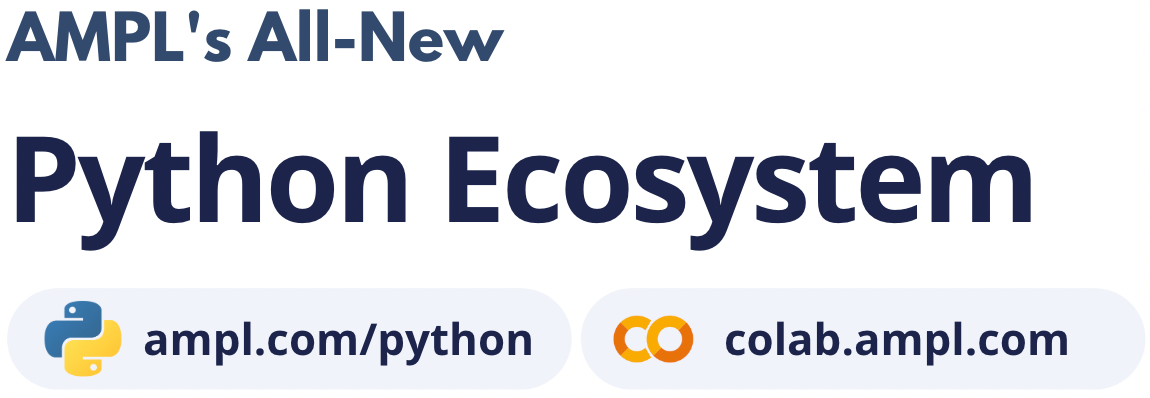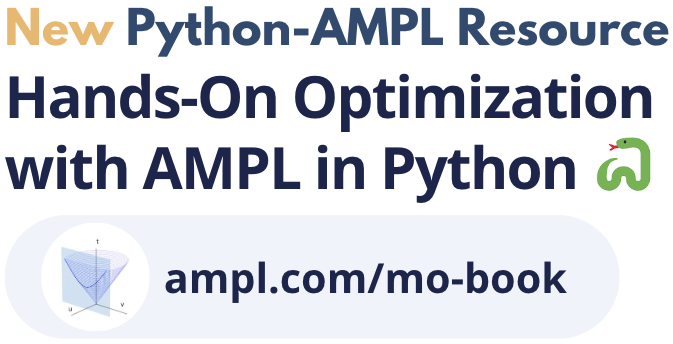Marcos Dominguez Velad (31 notebooks)#
Book Example: Economic equilibria#
Description: economic model using complementarity conditions from Chapter 19 AMPL book
Book Example: Transshipment problem#
Description: Basic book example with general transshipment model (net1.mod)
Book Example: diet#
Description: book example autogenerated using diet.mod, diet.dat, and diet.run
Containers scheduling#
Description: Scheduling model for harbor operations. It is a problem with dependences between containers, which should be dispatch the fastest possible. We are using the MP solver interfaces to model a complex system using techniques from Constraint Programming, such as indicator constraints, and logical or and forall operators. After the model is written, a couple instances are presented and Highs/Gurobi MIP solvers are used to tackle the problem.
Demand prediction and Optimization with scikit-learn & Amplpy#
Description: In this notebook, we will:
Diagnose infeasibility#
Description: This notebook demonstrates how to deal with infeasible models.
Diet and Other Input Models: Minimizing Costs#
Description: Diet case study, Chapter 2 from the AMPL book adapted to Python
Tags: amplpy, ampl-lecture
Economic equilibria problem with PATH solver#
Description: showcase of the PATH solver via Kestrel interface and Neos server to solve economic model using complementarity conditions from the AMPL book
Employee Scheduling Optimization#
Description: Employee scheduling model from the Analytical Decision Modeling course at the Arizona State University.
Google Hashcode 2022#
Description: Google Hashcode 2022 Practice Problem
Hospitals-Residents MIP#
Description: hospitals-residents problem with ties problem solved with ampl and highs
Identifying active constraints with Ampl#
Description: This notebook demonstrates how to inspect the status of constraints in an AMPL model using the astatus() method provided by amplpy. It shows how to identify which constraints are currently active (i.e., participating in the optimization) and filter out those that have been dropped, presolved, or otherwise excluded
Tags: tutorials
Labs scheduling#
Description: Model for laboratories scheduling. Some labs are needed to handle requests from researchers, and departments have to assign labs and locations to the requests.
Largest small polygon#
Description: lecture about models for the Largest Small Polygon Problem
Magic sequences#
Description: Solving magic sequences through reinforced formulations and constrained programming. Some comparison between models and solvers is done, and we look into the “Another solution” problem for these sequences.
Tags: constraint-programming, educational, mp, sequences, arithmetic, reinforced-formulations, highs, gecode, cbc, mip
Multicommodity transportation problem#
Description: Multicommodity transportation model with binary variables
NFL Team Rating#
Description: NFL Team Rating problem from the Analytical Decision Modeling course at the Arizona State University.
Nonlinear transportation model#
Description: Nonlinear transportation problem with Amplpy nltransd.mod, nltrans.dat, and nltrans.run
Nonlinear transportation problem example#
Description: book example autogenerated using nltransd.mod, nltrans.dat, and nltrans.run
Optimization Methods in Finance: Chapter 3#
Description: Optimization Methods in Finance: Bond Dedication Problem.
P-Median problem#
Description: this notebook states the p-median problem with a simple example, and a MIP formulation in amplpy. The problem is parametrized with a class, so it is easier to sample and replicate experiments. A graphical solution is plotted.
Power System Optimization with Amplpower package#
Description: this notebook uses amplpower package to solver opf problems
Predicting and Optimizing Avocado Sales with Python + Amplpy#
Description: In this notebook, we explore a real-world example of demand estimation and supply optimization using a Kaggle dataset on avocado sales. We start by training a machine learning model to estimate demand and then formulate and solve an optimization model in AMPL to maximize revenue while minimizing waste and transportation costs.
Production model#
Description: generic model for production problem
Retrieve Solution pool with AMPL and Gurobi#
Description: This notebook describes how to retrieve multiple solutions from the solver’s solution pool. Optimization problems usually have several optimal solutions, one is returned by the solver but the others are discarded. These alternative solutions can also be retrieved by AMPL.
Steel industry problem#
Description: model for steel production problem
Sudoku Generator#
Description: Generate Sudoku boards with unique solution via iterative method and mip formulation.
Supply chain network#
Description: Compute optimal routes to connect suppliers/demanding nodes in a network. Routes have an associated fixed and variable cost. There are different products to ship. The problem is formulated as a MIP with binary variables. Python data structures are used to load the data into the model.
Transportation problem#
Description: an AMPL model for the transportation problem
Tags: ampl-only, ampl-lecture
Vehicle Routing Problem with Fair Profits and Time Windows (VRP-FPTW)#
Warehouse location and transport#
Description: Model for warehouse allocation. Farms (suppliers) send feedstock to warehouses, and later on, those warehouses send it to a production plant. The problem involves modeling a storage facility location problem with a transportation component to the final plant.





